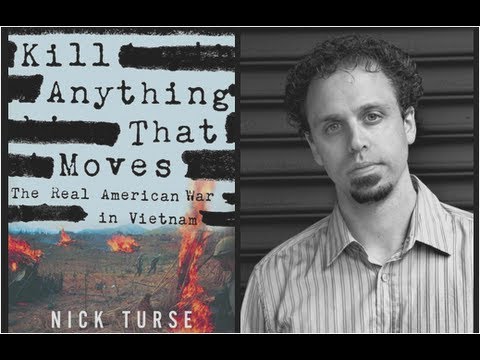For weeks Nick Turse’s new book has been rattling around in my head. Kill Anything That Moves: The Real American War in Vietnam is not just another history book. Its implications for today are both profound and unnerving. It will haunt you every time the United States launches yet another military adventure somewhere in the world in the name of American idealism.
How to convey 260 meticulously documented, explosive pages of horror stories? On every page there’s a new one, barely believable, that demands to be shared. Maybe you begin with My Lai, the scandal we still all know about, the one that has borne the burden as America’s shameful bad apple in Vietnam. Until now.
In March 1968, briefing the infantrymen of Charlie Company on their next operation in the Vietnamese countryside, Captain Ernest Medina instructs them “to kill everything that breathed.” When a solder asks, “Are we supposed to kill women and children?” Medina replies, in the commandment that encapsulates the entire American strategy for Vietnam, “Kill everything that moves.”
American soldiers are trained to obey. For four hours, the entire company proceeds to “methodically slaughter more than 500 unarmed victims,” all women, children and old men. “Along the way, they also rape women and young girls, mutilate the dead, systematically burn homes, and foul the area’s drinking water.” It sounds like one of those barbaric stories out of the Congo. The infantrymen, Turse learns, “even took a quiet break to eat lunch in the midst of that carnage.” I’m not sure they do that in Congo.
The massacre was witnessed by scores of men on the ground and in the air, including officers. In the end, a man named Calley, a company lieutenant, was the only person ever convicted of any wrongdoing. He was paroled after serving 40 months in his own quarters.
My Lai was no aberration. It was how the American brass military chose to conduct their war against Vietnam. It was just another American operation, as the archives Turse burrowed in and the eyewitnesses he tracked down all confirmed. He found a letter from a vet to President Richard Nixon, warning him that “the atrocities committed in My Lai are eclipsed by similar American actions throughout the country.” It has taken until now for the world to learn that truth.
At least 65,000 North Vietnamese civilians were killed, mostly in American air raids. South Vietnamese civilian deaths might have reached two million, wounded civilians five million; the country’s population had been 19 million. About a third of the wounded were women. A quarter were children under 13. Between 30-60,000 South Vietnamese were left blind, up to 150,000 more were amputees.
Forget about those convenient “bad apples.” These deaths and casualties were, Turse demonstrates, “the inevitable outcome of deliberate policies, dictated at the highest level of the military.” Whether on the ground or through “the everyday exercise of the American way of war from the air,” the killing of civilians was “widespread, routine and directly attributable to U.S. command policies.”
What comes as sadly predictable in Turse’s account is the explicit dehumanizing racism that was ubiquitous throughout the American forces and encouraged at every level. “The drill instructors never ever called the Vietnamese ‘Vietnamese’,” one vet remembered. “They called them dinks, gooks, slopes, slants, rice-eaters, everything that would take away their humanityŠThat they were less than human was clearly the message.”
“They were like animals,” another said. “They wouldn’t allow you to talk about them as if they were people. They told us that they’re not to be treated with mercy.” So obediently, and often enthusiastically, American soldiers killed or violated anything that moved, no questions asked.
Never mind mere terrorism. This is the direct route to genocide. Indeed, when a third of a small nation is left dead or maimed, what need is there for genocide?
Then add to this picture the systematic use in unprecedented quantities of Agent Orange, sprayed on nearly five million Vietnamese, their land, animals and vegetation. The consequences, short- and long-term, beggar description. Yet this too was no anomaly but the calculated use of chemical weapons as approved by the very highest political and military officials in the Kennedy, Johnson and Nixon administrations, some of the most eminent of them still active today. Yet using chemicals against civilian populations was the precise genocidal crime for which Saddam Hussein was to be tried had he lived, and the same crime if used by the Syrian government that will be a “game changer” for the Americans in that crisis, as Mr. Obama regularly informs us.
If My Lai was not an aberration in Vietnam, can we fail to ask whether Vietnam was an aberration among America’s never-ending wars? In fact, we already some answers. An independent U.S. commission has just confirmed that ever since 9/11, in Guatanamo, in Afghanistan, in Iraq, and in the CIA’s many secret “black sites” for detaining prisoners around the world, Americans indisputably “engaged in the practice of torture” as sanctioned by the Bush administration. It’s extremely disturbing, not least for America’s friends and allies.
Why does all this matter so profoundly? It’s not that Americans are more brutal than other soldiers; that’s a contest with no winner. It’s that America fights so many more wars than anyone else, often with our blessing.
This article originally appeared in the Globe and Mail.
Photo: Nick Turse



